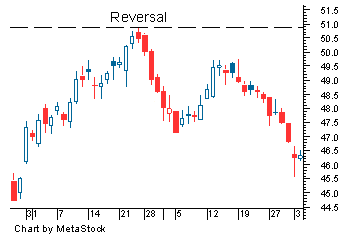Reversal
A change in the direction of a price trend. On a price chart, reversals undergo a recognizable change in the price structure. An uptrend, which is a series of higher highs and higher lows, reverses into a downtrend by changing to a series of lower highs and lower lows. A downtrend, which is a series of lower highs and lower lows, reverses into an uptrend by changing to a series of higher highs and higher lows.
Also referred to as a "trend reversal", "rally" or "correction".

A reversal can be a positive or negative change against the prevailing trend. Technical analysts watch for these patterns because they can indicate the need for a different trading strategy on the same security.
For example, if a technical analyst holds stock ABC and notices a reversal pattern, he or she may want to consider closing his or her existing long position and assuming a short position to capitalize on the potential downward movement of the stock's price.
Also referred to as a "trend reversal", "rally" or "correction".

A reversal can be a positive or negative change against the prevailing trend. Technical analysts watch for these patterns because they can indicate the need for a different trading strategy on the same security.
For example, if a technical analyst holds stock ABC and notices a reversal pattern, he or she may want to consider closing his or her existing long position and assuming a short position to capitalize on the potential downward movement of the stock's price.
附件列表
词条内容仅供参考,如果您需要解决具体问题
(尤其在法律、医学等领域),建议您咨询相关领域专业人士。
如果您认为本词条还有待完善,请 编辑
上一篇 Reversal Amount 下一篇 Rising Bottom
